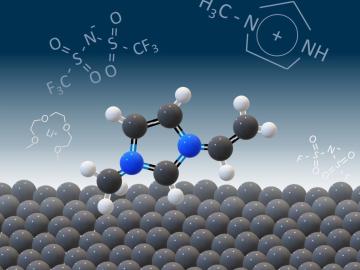
Filter News
Area of Research
- (-) Materials (79)
- (-) Nuclear Science and Technology (11)
- Advanced Manufacturing (2)
- Biological Systems (1)
- Biology and Environment (34)
- Computational Biology (2)
- Computational Engineering (1)
- Computer Science (4)
- Electricity and Smart Grid (3)
- Energy Science (111)
- Energy Sciences (1)
- Functional Materials for Energy (2)
- Fusion and Fission (8)
- Isotope Development and Production (1)
- Isotopes (29)
- Materials for Computing (7)
- National Security (34)
- Neutron Science (34)
- Quantum information Science (2)
- Sensors and Controls (2)
- Supercomputing (45)
News Topics
- (-) Biomedical (8)
- (-) Cybersecurity (5)
- (-) Energy Storage (34)
- (-) Grid (5)
- (-) Isotopes (16)
- (-) Physics (30)
- (-) Security (2)
- (-) Space Exploration (7)
- 3-D Printing/Advanced Manufacturing (26)
- Advanced Reactors (14)
- Artificial Intelligence (9)
- Big Data (2)
- Bioenergy (12)
- Biology (4)
- Buildings (5)
- Chemical Sciences (32)
- Clean Water (3)
- Composites (9)
- Computer Science (19)
- Coronavirus (5)
- Critical Materials (13)
- Environment (16)
- Exascale Computing (2)
- Frontier (3)
- Fusion (15)
- High-Performance Computing (4)
- Irradiation (1)
- ITER (1)
- Machine Learning (5)
- Materials (73)
- Materials Science (79)
- Mathematics (1)
- Microscopy (27)
- Molten Salt (7)
- Nanotechnology (39)
- National Security (3)
- Neutron Science (38)
- Nuclear Energy (49)
- Partnerships (11)
- Polymers (17)
- Quantum Computing (3)
- Quantum Science (11)
- Simulation (1)
- Summit (2)
- Transportation (14)
Media Contacts

A team led by Oak Ridge National Laboratory developed a novel, integrated approach to track energy-transporting ions within an ultra-thin material, which could unlock its energy storage potential leading toward faster charging, longer-lasting devices.

Scientists seeking ways to improve a battery’s ability to hold a charge longer, using advanced materials that are safe, stable and efficient, have determined that the materials themselves are only part of the solution.

After its long journey to Mars beginning this summer, NASA’s Perseverance rover will be powered across the planet’s surface in part by plutonium produced at the Department of Energy’s Oak Ridge National Laboratory.

From materials science and earth system modeling to quantum information science and cybersecurity, experts in many fields run simulations and conduct experiments to collect the abundance of data necessary for scientific progress.

Oak Ridge National Laboratory scientists seeking the source of charge loss in lithium-ion batteries demonstrated that coupling a thin-film cathode with a solid electrolyte is a rapid way to determine the root cause.

In the search to create materials that can withstand extreme radiation, Yanwen Zhang, a researcher at the Department of Energy’s Oak Ridge National Laboratory, says that materials scientists must think outside the box.

Oak Ridge National Laboratory researchers have discovered a better way to separate actinium-227, a rare isotope essential for an FDA-approved cancer treatment.

Research by an international team led by Duke University and the Department of Energy’s Oak Ridge National Laboratory scientists could speed the way to safer rechargeable batteries for consumer electronics such as laptops and cellphones.

Oak Ridge National Laboratory researchers have developed a thin film, highly conductive solid-state electrolyte made of a polymer and ceramic-based composite for lithium metal batteries.

In the race to identify solutions to the COVID-19 pandemic, researchers at the Department of Energy’s Oak Ridge National Laboratory are joining the fight by applying expertise in computational science, advanced manufacturing, data science and neutron science.


